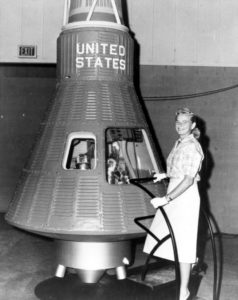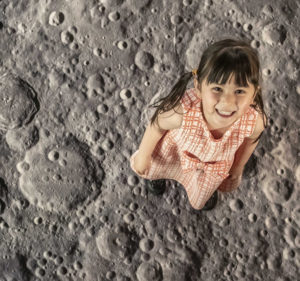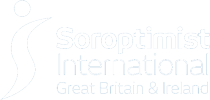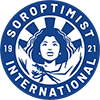Today is the International Day of Human Space Flight. Louie Clegg reminisces on the 1969 moon landing and the history of women in space…
It was July 1969 my last year at junior school when Apollo 11 landed on the moon. As a class we were sooooo excited as we were allowed to watch it ‘live’ on the television in the classroom. A television in the class what were they thinking?!
To be honest on that day it never occurred to me that there weren’t any women on board, I remember the teacher telling us there had been a chimpanzee in orbit and several other people but nobody had even been to the moon let alone walked on it. I felt it a little overwhelming when I had yet to travel on a plane.
But when researching for this article I discovered there were some very capable women who could have been included but were forbidden due to their sexuality.

Take for instance Jerrie Cobb. She gained her Private Pilot’s license at the age of 17 and her Commercial Pilot’s license on her 18th birthday. Facing sex discrimination and the return of many qualified male pilots after World War II, she took on less-sought-after flying jobs, such as patrolling pipelines and crop dusting. She went on to earn her Multi-Engine, Instrument, Flight Instructor and Ground Instructor ratings as well as her Airline Transport license. At the age of 21 she was delivering military fighters and four-engine bombers to foreign Air Forces worldwide.
Cobb set three aviation records in her 20s: the 1959 world record for nonstop long-distance flight, the 1959 world light-plane speed record, and a 1960 world altitude record for lightweight aircraft of 37,010 feet (11,280 m; 11.28 km).When Cobb became the first woman to fly in the Paris Air Show, the world’s largest air exposition, her fellow airmen named her Pilot of the Year and awarded her the Amelia Earhart Gold Medal of Achievement. Life Magazine named her one of the nine women of the “100 most important young people in the United States”.
In May 1961 NASA Administrator James Webb appointed Cobb as a consultant to the NASA space program. Although she never flew in space, Cobb, along with twenty-four other women, underwent physical tests similar to those taken by the Mercury astronauts with the belief that she might become an astronaut trainee. All the women who participated in the program, known as First Lady Astronaut Trainees, were skilled pilots. Dr. Randy Lovelace, a NASA scientist who had conducted the official Mercury program physicals, administered the tests at his private clinic without official NASA sanction. Cobb passed all the training exercises, ranking in the top 2% of all astronaut candidates of both genders.
In 1962, Cobb was called to testify before a Congressional hearing, the Special Subcommittee on the Selection of Astronauts, about women astronauts. Astronaut John Glenn stated at the hearing that “men go off and fight the wars and fly the airplanes”, and “the fact that women are not in this field is a fact of our social order”. Only a few months later, the Soviet Union would send the first woman into space.
Cosmonaut Valentina Tereshkova of the Soviet Union was the first woman to fly in space. She launched on 16 June 1963 in Vostok 6, for 48 orbits and a total of 70 hours 50 minutes in space (more than all the US Mercury astronauts combined).
The U.S. did not send a woman into space until July 18, 1983, when Sally Ride, an astronaut and physicist, flew aboard space shuttle Challenger.
Challenger flew again in October 1984 with Sally Ride and Kathryn Sullivan. Sullivan was the third American woman in space and the first to walk in space.
- Shannon Lucid has logged more continuous time in space than any other U.S. astronaut, male or female, having spent seven months on board the MIR space station in 1996.
- Mae Jemison became the first African-American woman in space on September 12, 1992, when she launched on space shuttle Endeavor.
- Judy Resnik was the first Jewish astronaut, and the second American woman in space, when she launched aboard space shuttle Endeavor in August 1984. She and teacher astronaut Christa McAuliffe died in the space shuttle Challenger mishap on January 28, 1986.
- Eileen Collins was the first woman to pilot a space shuttle, Discovery, in February 1995. She was also the first woman to command a space shuttle, Columbia, in July 1999.

Then of course there is our very own Helen Sharman, CMG, OBE, HonFRSC, a chemist who became the first British astronaut and first Western European woman in space (and in particular, the first British cosmonaut) as well as the first woman to visit the Mir space station in May 1991.
After responding to a radio advertisement asking for applicants to be the first British space explorer, Helen Sharman was selected for the mission live on ITV, on 25 November 1989, ahead of nearly 13,000 other applicants. The programme was known as Project Juno and was a cooperative Soviet Union–British mission co-sponsored by a group of British companies.
Sharman was selected in a process that gave weight to scientific, educational and aerospace backgrounds as well as the ability to learn a foreign language.
Before flying, Sharman spent 18 months in intensive flight training in Star City (Moscow not Birmingham.) The Project Juno consortium failed to raise the monies expected, and the programme was almost cancelled. With a view towards the flight’s impact on international relations, the project proceeded under Soviet expense although as a cost-saving measure, less expensive experiments were substituted for those in the original plans.
The Soyuz TM-12 mission, which included Soviet cosmonauts Anatoly Artsebarsky and Sergei Krikalev, launched on 18 May 1991 and lasted eight days, most of that time spent at the Mir space station. Sharman’s tasks included medical and agricultural tests, photographing the British Isles, and participating in a licensed amateur radio hookup with British schoolchildren. She landed aboard Soyuz TM-11 on 26 May 1991, along with Viktor Afanasvey and Manarov.
Sharman was 27 years and 11 months old when she went into space, making her (as of 2017) the sixth youngest of the 556 individuals who have flown in space. Sharman has not returned to space, although she was one of three British candidates in the 1992 European Space Agency astronaut selection process and was on the shortlist of 25 applicants in 1998.
Helen visited Lichfield Cathedral in 2019 to celebrate the 50th anniversary of the first moon landing and the The Great Exhibition ‘SPACE: God, the Universe and Everything’, a stunning visual spectacle inspired by the Moon landing.
Created by the award-winning Luxmuralis artistic collaboration, the exhibition features internal Son-et-Lumiere, artworks, and sound and light installations that transformed the internal space of the Cathedral.
The tickets literally sold out overnight where she captivated the audience with her experiences a true pioneer and a role model for young people (of all ages!)

This young lady had the opportunity to ‘walk on the moon’ recreated on the Cathedral floor by local artist Peter Walker.
Let us celebrate all these amazing women on today International Day of Human Space flight.

